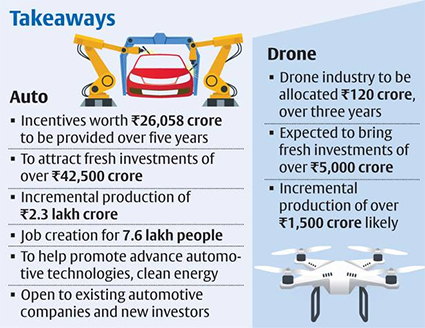Context:
The Union government has approved a Production Linked Incentive (PLI) Scheme for Auto Industry and Drone Industry with a budgetary outlay of Rs. 26,058 crore.
Relevance:
GS-III: Industry and Infrastructure (Industrial Growth, Industrial Revolution), GS-III: Indian Economy (Growth and Development of Indian Economy)
Dimensions of the Article:
- PLI Scheme for Auto Industry
- PLI Scheme for Drone Industry
- Significance of the schemes
PLI Scheme for Auto Industry
- The PLI scheme for the auto sector will incentivize high value Advanced Automotive Technology vehicles and products.
- It envisages overcoming the cost disabilities to the industry for the manufacture of Advanced Automotive Technology products in India.
- The incentive structure will encourage industry to make fresh investments for indigenous global supply chain of Advanced Automotive Technology products.
- It is expected to bring in fresh investments to the tune of ₹42,500 crore, and lead to an incremental production of over ₹2.3 lakh crore.
- It is also estimated that it will create employment opportunities of over 7.5 lakh jobs.
- India’s share in the global automotive trade will get a push with this scheme.
- The scheme is open to existing automotive companies as well as new investors who are currently not in automobile or auto component manufacturing business.
- Two components of the scheme:
- Champion OEM Incentive Scheme: It is a ‘sales value linked’ scheme, applicable on Battery Electric Vehicles and Hydrogen Fuel Cell Vehicles of all segments.
- Component Champion Incentive Scheme: It is a ‘sales value linked’ scheme, applicable on Advanced Automotive Technology components of vehicles, Completely Knocked Down (CKD)/Semi Knocked Down (SKD) kits, Vehicle aggregates of 2-Wheelers, 3-Wheelers, passenger vehicles, commercial vehicles and tractors, etc.
- This scheme, along with the PLI scheme for Advanced Chemistry Cell (ACC) and the Faster Adaption of Manufacturing of Electric Vehicles (FAME) scheme will help India push towards the faster adoption of environmentally cleaner, sustainable, advanced and more efficient Electric Vehicles (EV) based system.
PLI Scheme for Drone Industry
- This scheme addresses the strategic, tactical and operational uses of drone technology.
- It is expected to help build capacity in this sector and make it the key driver of India’s growth strategy.
- It will lead to investments worth ₹ 5,000 Crore, increase in eligible sales of ₹ 1500 crore and create additional employment of about 10,000 jobs.
- The PLI scheme comes as a follow-through of the liberalised Drone Rules, 2021 released by the Central Government.
- The total outlay for the scheme is INR 120 crore spread over three financial years.
- The incentive for a manufacturer of drones and drone components shall be as high as 20% of the value addition made by the manufacturer.
- This PLI rate of 20% has been kept constant for the next three years only for the drone industry as an exceptional treatment. In other PLI schemes, the PLI rate reduces every year.
- The minimum value addition norm is at 40% of net sales instead of 50%, another exceptional treatment given to the drone industry.
- The minimum value addition norm is at 40% of net sales instead of 50%, another exceptional treatment given to the drone industry.
- The incentive payable to a manufacturer of drones and drone components shall be simply one-fifth of the value addition.
Significance of the schemes

- The scheme will provide a much needed boost to the auto sector railing under the impact of the pandemic.
- Incentivising local production through this scheme could translate into more investments in the auto segment. The government expects the scheme would lead to fresh investments of more than Rs. 42,500 crore, incremental production worth over Rs. 2.3 lakh crore and creation of an additional 7.5 lakh jobs.
- The incentive scheme could provide a much needed impetus to EV vehicles as well as those that use hydrogen fuel cells. The emphasis on these alternate fuel vehicles will help lower fossil fuel emissions as part of the efforts to meet commitments under climate change agreements. This will also help India reduce dependence on oil imports and ensure some degree of energy security for India.
-Source: The Hindu




